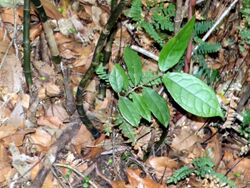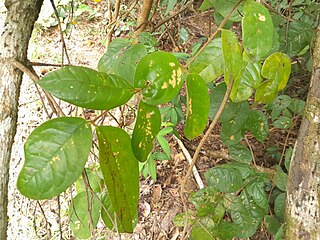Biology:Palmeria scandens
| Anchor vine | |
|---|---|

| |
Script error: No such module "Conservation status".
| |
| Scientific classification | |
| Kingdom: | Plantae |
| Clade: | Tracheophytes |
| Clade: | Angiosperms |
| Clade: | Magnoliids |
| Order: | Laurales |
| Family: | Monimiaceae |
| Genus: | Palmeria |
| Species: | P. scandens
|
| Binomial name | |
| Palmeria scandens | |

| |
| Synonyms[2] | |
| |
Palmeria scandens, commonly known as the anchor vine or pomegranate vine, is a climbing plant in the family Monimiaceae prevalent in rainforests of Queensland and New South Wales. It may also be present in New Guinea.
Description
Palmeria scandens is an evergreen woody vine with stems up to 20 cm (7.9 in) diameter. It is variable in its morphology and has several forms that are not considered to be distinct enough to warrant placing them into separate taxa.[3]
The simple leaves are elliptic to oblong, 4.5 to 19 cm (1.8 to 7.5 in) long by 4 to 9 cm (1.6 to 3.5 in) wide. They are pubescent, the margins are smooth or very finely toothed, and the petiole measures up to about 10 mm (0.39 in) long.[3][4][5]
The inflorescences are axillary; in male plants they are up to 9 cm (3.5 in) long with flowers about 9 mm (0.35 in) diameter, in female plants they are up to 2 cm (0.79 in) long with 3 mm (0.12 in) diameter flowers. The female receptacle is initially about 3 mm (0.12 in) diameter, enlarging after fertilisation to a somewhat fleshy false fruit containing up to 9 drupes. At maturity the swollen receptacle is about 25 mm (0.98 in) diameter and splits to reveal the contents. It is green outside, pink and hairy inside, with the red drupes (each containing a single seed) attached to the inner surface.[3][4][5]
Taxonomy
This species was first described in 1864 by Ferdinand von Mueller, who based his description on material collected by John Dallachy at Rockingham Bay.[1][6] His description was published in his tome Fragmenta phytographiæ Australiæ.
Etymology
The genus name was given by Mueller to honour the English-born Australian medical practitioner and politician James Frederick Palmer. The species epithet scandens is from Latin and means "climbing".[7]
Distribution
The anchor vine is widespread in rainforest from Batemans Bay in southeast New South Wales to the McIlwraith Range on Cape York Peninsula, Queensland, at altitudes from near sea level to 1,500 m (4,900 ft).[3][4][5] There is also a single recorded occurrence of this species in New Guinea.[8]
Conservation
This species is listed by the Queensland Department of Environment and Science as least concern.[9] (As of January 2023), it has not been assessed by the IUCN.
Gallery
References
- ↑ 1.0 1.1 "Palmeria scandens". Centre for Plant Biodiversity Research, Australian Government. https://id.biodiversity.org.au/name/apni/65296.
- ↑ 2.0 2.1 "Palmeria scandens F.Muell.". Royal Botanic Gardens, Kew. https://powo.science.kew.org/taxon/urn:lsid:ipni.org:names:582191-1.
- ↑ 3.0 3.1 3.2 3.3 Whiffin, T.; Foreman, D.B. (2021). "Palmeria scandens". Australian Biological Resources Study, Department of Climate Change, the Environment and Water: Canberra. https://profiles.ala.org.au/opus/foa/profile/Palmeria%20scandens.
- ↑ 4.0 4.1 4.2 "Palmeria scandens". Centre for Australian National Biodiversity Research (CANBR), Australian Government. 2020. https://apps.lucidcentral.org/rainforest/text/entities/Palmeria_scandens.htm.
- ↑ 5.0 5.1 5.2 "PlantNET - FloraOnline". Royal Botanic Gardens and Domain Trust, Sydney. https://plantnet.rbgsyd.nsw.gov.au/cgi-bin/NSWfl.pl?page=nswfl&lvl=sp&name=Palmeria~scandens.
- ↑ Mueller, Ferdinand von (1864). Fragmenta phytographiae Australiae. 4. Melbourne: Joannis Ferres. p. 152. https://www.biodiversitylibrary.org/page/761317. Retrieved 29 January 2023.
- ↑ Cooper, Wendy; Cooper, William T. (June 2004). Fruits of the Australian Tropical Rainforest. Clifton Hill, Victoria, Australia: Nokomis Editions. p. 318. ISBN 9780958174213. https://www.nokomis.com.au/product/nokomis-published-books/fruits-australian-tropical-rainforest/.
- ↑ Conn, B.J.; Banka, R.; Lee, L.L.. "Plants of Papua New Guinea". https://www.pngplants.org/cgi-bin/RBG.
- ↑ "Species profile—Palmeria scandens". Queensland Government. 2022. https://apps.des.qld.gov.au/species-search/details/?id=16565.
Wikidata ☰ Q18080092 entry
 |




